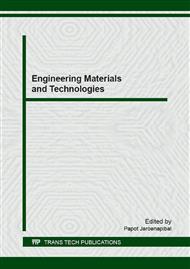p.57
p.62
p.67
p.72
p.77
p.81
p.87
p.95
p.100
Rice Hull Micro and Nanosilica: Synthesis and Characterization
Abstract:
Rice hull is a by-product natural material composing of high amount of silica. In this work, silica microparticles were synthesized from rice hull using 3 temperature levels of calcination at 500, 600, and 850 ºC. Then, they were transformed to silica nanoparticles by precipitation method using sodium silicate as an initial substance synthesized from rice hull. Finally, the properties of silica particle were studied such as characteristics, morphology of particle, component, and size of silica. The result showed the silica structure became more crystalline when the temperature was increased. When the concentration of sodium silicate increased, more agglutination occurred in the silica structure. The results also indicated that the particle size and component of silica synthesized by heating rice hull at 600 ºC followed by precipitation method were the same as those of commercial silica.
Info:
Periodical:
Pages:
77-80
Citation:
Online since:
November 2016
Keywords:
Price:
Сopyright:
© 2017 Trans Tech Publications Ltd. All Rights Reserved
Share:
Citation:


